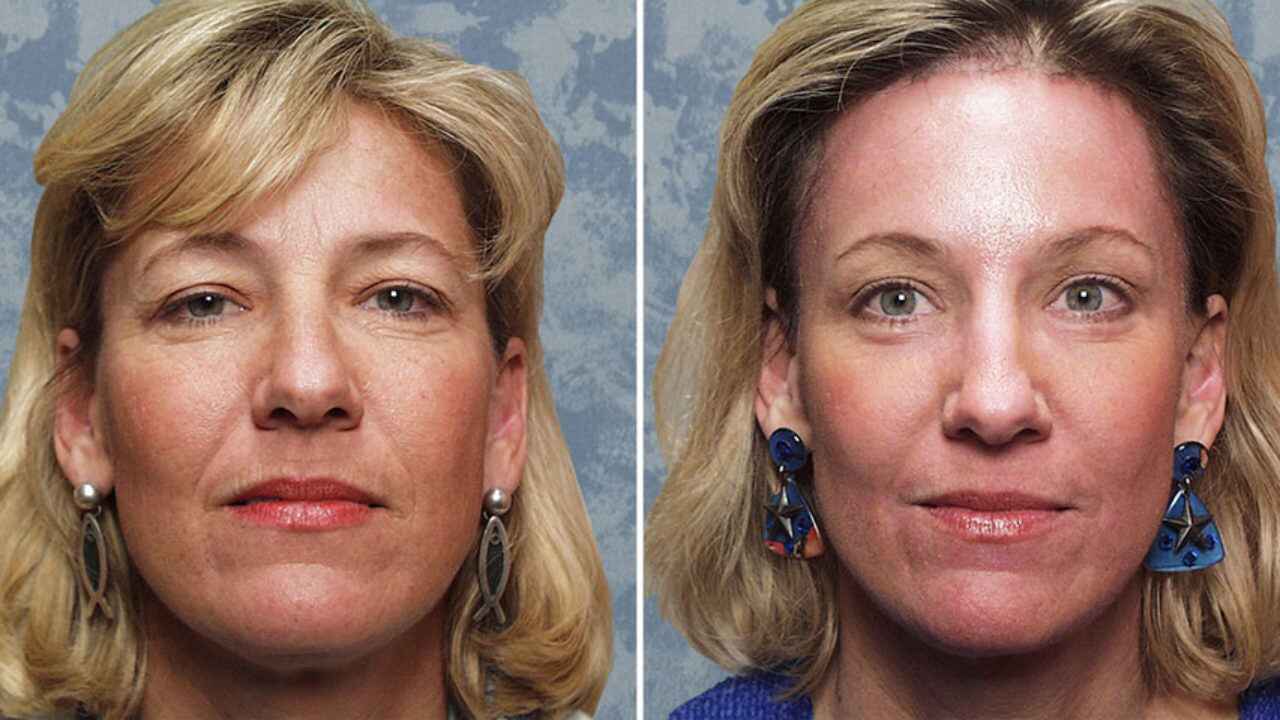Brow lifts are currently one of the most popular trends in beauty and cosmetic surgery. This procedure reshapes the forehead, reduces wrinkles, and raises the eyebrows, resulting in a younger, fresher, and more alert appearance. Whether performed through surgical procedures or nonsurgical methods like Botox, a brow lift can be a great way to improve your appearance. Here, we’ll take a look at the surgical procedure.
- Who is a brow lift for?
- Types of Brow Lifts
- 1. Endoscopic Brow Lift
- 2. Crown Brow Lift
- 3. Temporal Brow Lift (Limited Incision)
- 4. Non-Surgical Brow Lift
- Why get a brow lift?
- How common is a brow lift in the United States?
- What to expect during a brow lift?
- What happens after a brow lift?
- How long will it take for me to get back to normal?
- Risks and Possible Complications
- What are the important things to consider when choosing a surgeon?
- When should I call my doctor?
- How Much Does an Eyebrow Lift Cost?
- The Final Word
Who is a brow lift for?
For people who:
- Are in good overall health.
- Have realistic expectations.
- Are bothered by drooping eyebrows, forehead wrinkles, or asymmetry.
If you are unsure, start with a consultation. Your surgeon can recommend the best procedure based on your unique features and goals.
Types of Brow Lifts
1. Endoscopic Brow Lift
This procedure is widely considered the most advanced and common method for brow lifting.
Procedure:
The surgeon makes several small incisions along the hairline, usually less than an inch long. Through these incisions, they insert a small camera (endoscope) to guide their work. They use specialized instruments to adjust the muscles and underlying tissues that cause brow droop and forehead wrinkles.
Pros:
- Minimal scarring due to small incisions.
- Faster healing than other surgical procedures.
- Very precise, allowing for natural-looking results.
Who it’s for:
Ideal for people with moderate droop or forehead wrinkles who want a subtle, subtle lift without extensive surgery.
2. Crown Brow Lift
The crown brow lift, also known as a traditional or open brow lift, has been a popular procedure for decades.
Procedure:
A single, long incision is made on the top of the head, usually hidden by the hairline. The skin is lifted and excess tissue or fat is removed. The muscles responsible for sagging or frowning are adjusted, and the remaining skin is repositioned for a smoother, more prominent appearance.
Pros:
- The best option for significant sagging or asymmetry.
- Long-lasting results due to comprehensive adjustments made during surgery.
Cons:
- Longer recovery time than other procedures.
- May leave more visible scars, especially for those with thinning hair.
Who it’s for:
Suitable for those with severely sagging eyebrows or deep forehead wrinkles who need a more dramatic correction.
3. Temporal Brow Lift (Limited Incision)
This method is a less invasive alternative that focuses on the outer edges of the eyebrows.
Procedure:
Small incisions are made near the temples, just behind the hairline. The skin surgeon lifts and tightens the outer area of the brow without altering the central part of the forehead.
Pros:
- Minimal scarring due to smaller incisions.
- Faster healing time compared to a full coronal or endoscopic brow lift.
- Subtle results for a fresh look.
Who it’s for:
Ideal for those who need a minor lift on the outer area of the brow or want to correct mild drooping without undergoing a full procedure.
4. Non-Surgical Brow Lift
A non-surgical brow lift uses injectables such as Botox and dermal fillers to achieve a temporary lifting effect.
Procedure:
Botox: Strategically injected into specific muscles to relax them, allowing the brow to lift slightly.
Filler: Used to add volume to the area around the brow, creating a more prominent and fuller appearance.
Pros:
- No downtime or recovery period – patients can return to their daily activities immediately.
- Completely non-invasive
- Adjustable for subtle, temporary improvements.
Cons:
- Results are temporary, typically lasting 3-6 months.
- Requires regular maintenance appointments to maintain the look.
Who is it for:
Ideal for those looking for a quick, temporary solution without surgery. Also great for those who want to “test the waters” before deciding on a permanent brow lift.
Choosing the Right Brow Lift
Choosing best procedure depends on your needs, preferences, and goals. Consulting with a board-certified surgeon can help determine the right procedure for you based on your facial structure, skin elasticity, and desired results.
Why get a brow lift?
People choose a brow lift for a variety of reasons:
- Asymmetry: Uneven brows can be balanced with a lift.
- Wrinkles: Deep lines on your forehead or between your eyebrows can be bothersome.
- Tired appearance: Sagging brows can make you look older or more tired than you feel.
- Increased self-confidence: looking good often helps us feel good.
How common is a brow lift in the United States?
Brow lifts are very common, with more than 88,000 procedures performed in the United States each year. More than 90 percent of patients are female or those assigned female at birth. Men and those assigned male at birth account for less than 10 percent of brow lifts nationwide.
What to expect during a brow lift?
Preoperative preparation
Before surgery, you will meet with your surgeon. This is an opportunity to discuss your goals, ask questions, and review your medical history. You may also need to stop taking certain medications and quit smoking to prepare for the day of surgery.
The surgery itself
Depending on the procedure, you will be given anesthesia during your brow lift to ensure you do not feel any pain.
The procedure usually takes 1-3 hours.
Your surgeon will make precise incisions, adjust the tissues, and secure the eyebrows in their new position. Once everything is in place, the incisions will be closed with stitches or surgical staples.
What happens after a brow lift?
- After a brow lift, you may experience some swelling, bruising, and mild discomfort around your forehead and eyebrow area. A bandage may be applied to protect the incisions and minimize swelling.
- Try to help reduce swelling by keeping your head elevated and using cold compresses for the first few days.
- Your surgeon may prescribe pain medication to control any discomfort.
How long will it take for me to get back to normal?
- Most people can resume light activities within a week, but strenuous exercise and heavy lifting should be avoided for at least 4-6 weeks.
- Swelling and bruising usually subside within a few weeks, and the full results of the procedure will be more visible as the area heals.
- Your surgeon will provide you with aftercare instructions for your brow lift to ensure you get the best possible results.
Risks and Possible Complications
Like any surgery, a brow lift has risks. These include:
- Infection
- Scars
- Bleeding
- Numbness
- Adverse reaction to anesthesia
- Nerve damage (rare)
- Asymmetry or dissatisfaction with the results
- Adverse reaction to anesthesia
- Pain
- Severe itching
To minimize these risks, be sure to choose a board-certified and highly experienced surgeon.
What are the important things to consider when choosing a surgeon?
- Make sure the surgeon you are considering is board certified.
- Try to talk to a few previous clients who have had a brow lift under the surgeon you are considering.
- Look at before and after photos of clients. This will give you an idea of the work.
- Be sure to discuss all your questions, concerns, and expectations with your surgeon.
When should I call my doctor?
- Severe pain
- Excessive swelling
- Bleeding from the surgical site
- Fever over 100 degrees Fahrenheit (37.77 degrees Celsius)
How Much Does an Eyebrow Lift Cost?
Costs can vary depending on the technique and your location. On average, you’re looking at $3,000 to $8,000. Keep in mind that health insurance doesn’t cover this because it’s considered a cosmetic procedure.
If cost is a concern, ask your clinic about payment plans or financing options.
The Final Word
A brow lift can transform your face, giving you a fresh, youthful look that matches how you feel inside. Although making the decision isn’t easy, those who are prepared find the results worthwhile.
So, if you’re looking at those drooping eyebrows in the mirror and wondering if there’s a solution, it may be time to try brow lift surgery. To see if this procedure is right for you, consult with a qualified practitioner.














